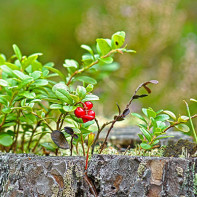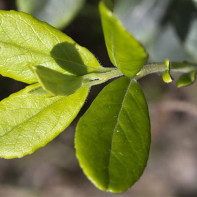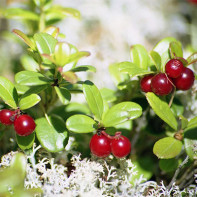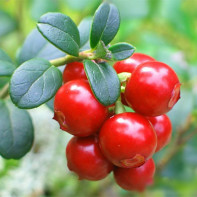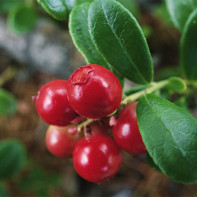Lingonberry leaves: medicinal properties and contraindications
Lingonberry is a plant that is valuable not only for its fragrant scarlet berries. Almost all parts of the shrub can be used for medicinal purposes. But the greatest value are the leaves. They contain a large number of active substances affecting the nervous system and immunity, restoring blood composition. Lingonberry leaves can be harvested and used all year round for a variety of diseases and disorders.
- Chemical composition
- Gathering and storage
- Therapeutic properties of lingonberry leaves
- For women
- For Men
- In pregnancy
- For breastfeeding
- For children
- For weight loss
- Lingonberry leaves in folk medicine
- Diabetes mellitus
- With pancreatitis
- For gastritis
- With gout
- For the liver
- For cystitis
- For prostatitis
- For colds
- For varicose veins
- For mastopathy
- For pyelonephritis
- Hypertension
- Kinds of medicinal compositions
- Infusion
- Infusion
- Decoction
- Tea
- Cosmetic applications
- Contraindications to use
Chemical Composition
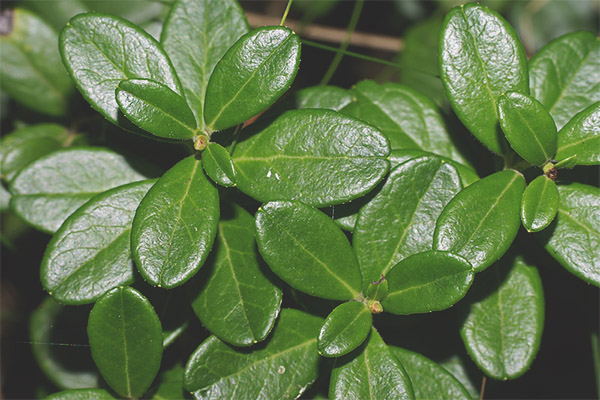
Lingonberries are considered almost a panacea for all diseases. But other parts of this plant also have the same properties. The leaves are indispensable in alternative medicine, because they have a rich composition. Chemical analysis of plant raw materials revealed that it contains such substances:
- phytoncides;
- arbutin;
- tannins;
- antioxidants;
- organic acids;
- B vitamins;
- rutin;
- ascorbic acid;
- magnesium;
- zinc;
- manganese;
- iron.
Thanks to these substances preserved in the process of drying, cranberry leaves have a beneficial effect on the human body. They do not lose their value even when stored for a long time (up to 1 year).
Harvesting and Storage
There is a perception that lingonberry leaves can be collected and dried at any time. But this is not true. To harvest the raw material, you need to pick a good time, otherwise it will not be useful for therapeutic use. The fact is that during the growing season, when berries are formed and ripe, the plant directs all its resources to them. Therefore, active substances are not concentrated in the foliage. The best time to start harvesting is early spring, when flowering has not yet begun. After harvesting the berries you can also harvest the leaves.
The most common collection option is to cut off small shoots, twigs with leaves. It is necessary to put them in a basket or in a box, so that during transportation they are not damaged or crumpled. If you use a bag or cloth bag for collecting, make sure that the leaves are not crumpled and do not crush them.
You can dry them in various ways. If you have an electric dryer for fruit - you can load the plucked leaves on a pallet, turn on low temperature mode and in 4-6 hours to get ready raw materials. You can in the old fashioned way to spread a clean diaper and on it spread the collected leaves in a thin layer. Do not dry in the open sun - this will lead to the destruction of valuable vitamins and other active substances that are contained in the leaves. To preserve the benefits of plant raw materials for a long time, you need to pack it in a container with a lid, protect it from high humidity and temperature fluctuations.
Therapeutic properties of lingonberry leaves
Lingonberry leaves are a real godsend for folk medicine, because their properties are so numerous that allow using the raw material for a variety of conditions and diseases. The effects of herbal remedies and their benefits for men and women differ.
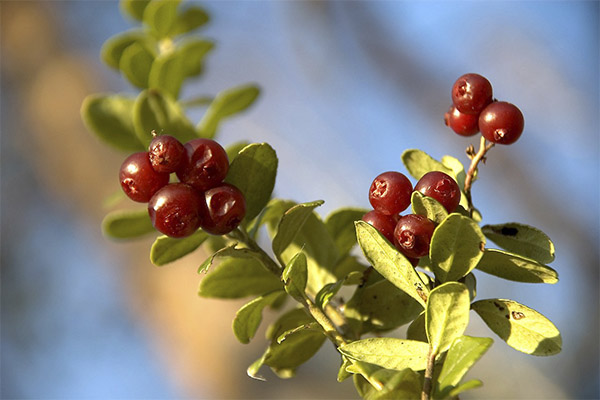
For women
For women's health, lingonberry leaves are an indispensable remedy. It helps to quickly restore hormonal balance. The main therapeutic properties that can be used for women:
- The ability to stop bleeding;
- normalization of the emotional state;
- effectiveness in diseases of the urogenital system, adnexitis, cystitis, mastopathy.
A woman's body loses a huge amount of active ingredients with the monthly onset of critical days. Lingonberry tea can make this period less painful, as well as help the body quickly recover from blood loss.
For men
Men's health can also be strengthened by using remedies based on lingonberry leaves. According to statistics, 55% of men over 40 have problems related to the genitourinary system. Lingonberry leaves help restore health in urethritis, slow down the natural aging process, prevent a number of dangerous diseases associated with the loss of reproductive capacity.
With prostatitis and infectious diseases of the urinary tract, the use of lingonberry can quickly relieve inflammation, eliminate discomfort and burning when urinating. Due to the general restorative effect and antioxidants, this medicine protects from the development of malignant neoplasms in the organs and tissues of the reproductive system.
When pregnant
Pregnant women in the first trimester are forbidden to use lingonberry leaves, as it can provoke a miscarriage. In the second and third trimester they can be an alternative remedy for colds, when strong pharmaceutical drugs are prohibited. Also in pregnancy, periodic consumption of lingonberry tea helps to make up for deficiencies in minerals, folic acid, and iron. Lingonberry leaves prevent the development of anemia.
But you can not drink infusion and decoction of this plant often, because it is fraught with low fertility. Lingonberry remedies have a pronounced diuretic effect, so you need to replenish fluid loss in time to avoid a dangerous condition.
When breastfeeding
Breastfeeding is not a contraindication to the use of remedies based on lingonberry leaves. But there are limitations. Reception should not be too long. It is also forbidden to use alcoholic tincture. The leaves are useful to nursing women and produce such effects:
- help quickly recover from childbirth;
- eliminate mineral and vitamin deficiencies;
- Strengthen the health of the nervous system;
- Prevent the development of pathological processes and congestion in the mammary glands.
In addition, if a nursing mother consumes remedies with lingonberry leaves, it is good for the child. It normalizes digestion, eliminates colic, reduces gas formation. Children sleep better, suffer less cramps and pains, and grow up calm.
For children
Even children over the age of 6 can be given tea from lingonberry leaves. This herbal remedy can help cope with colds faster, strengthen immunity. In addition, the leaves are rich in organic acids and mineral compounds that enrich the brain. The plant helps to cope with high intellectual stress, improves memory and concentration, stabilizes mental and intellectual development.
If a small amount of lingonberry berries is brewed together with the leaves, such a drink will improve appetite and normalize sleep. But you should not use it on a regular basis. Because of too frequent use, the child can become lethargic, as lingonberry slightly lowers blood pressure.
When losing weight
In the fight against excess weight, a mild laxative effect can be used, as well as the diuretic effect of the plant material. This plant is also useful in that it can activate energy metabolism and stimulate the process of lipid breakdown in the subcutaneous tissue. For obesity, lingonberry leaves can be used as an addition to the dietary diet.
Lingonberry leaves clean the blood vessels and improve blood microcirculation. The most common problem of all thinners is that there are very few blood vessels in the fatty tissue, so the process becomes more difficult. But lingonberry leaves make the blood circulate more actively and penetrate even the smallest capillaries, improving nutrition, as well as accelerating metabolic processes at the cell level. Due to this, the fat is lost faster, even in the most problematic areas. But do not count on the result only from lingonberry leaves. It is necessary to reduce the daily caloric intake, to move more and not forget to drink at least 2 liters of water a day.
Lingonberry leaves in folk medicine
In alternative medicine, lingonberries and their leaves are used for more than the first century. During this time, folk experience has managed to formulate the basic rules of application, and various treatment regimens have also been developed with the remedy for diseases. For the use of remedies to bring maximum benefit, it is worth choosing a suitable recipe and treatment regimen, according to the specifics of the diagnosis with which you need to cope.

Diabetes mellitus
Endocrine diseases lead to imbalances throughout the body. Diabetes mellitus is a problem that medicine has not yet learned how to defeat. The rate of development of the pathology cannot be predicted, but every year the number of people who fall ill increases. Doctors are concerned that diabetes is "getting younger", i.e. more and more children patients with this diagnosis are encountered. But in folk medicine there are a lot of recipes that will help to minimize the harm from diabetes mellitus. The most popular of them is the use of lingonberry leaf.
To normalize blood sugar levels, specialists in folk medicine recommend drinking tea from this plant on an empty stomach. It is also worth including the berries themselves in the diet, but without sugar. You can drink decoction of the plant by courses of 2 months, taking a break for the same period of time. For taking courses you need to prepare an infusion in a thermos of 1 tablespoon of raw materials and 400 ml of water. The resulting remedy after 6 hours, strain and divide into 4 parts. Drink in the morning and evening to 100 ml.
With pancreatitis
The inflamed pancreas is also favorably affected by the chemical composition of the plant. Due to antibacterial and anti-inflammatory properties, it is possible to block attacks and exacerbations. At the expense of antispasmodic action it turns out to relieve painful sensations. In addition, the plant reduces the rate of pancreatic enzyme production, thereby reducing the irritating effect on the tissue organ.
In diseases of the pancreas, the use of lingonberry remedies without a therapeutic diet has no effect. Gastroenterologists recommend the first three days to fast, take warm tea from the plant three times a day and drink mineral water without gas. Further treatment should be accompanied by a strict diet (table number 5) and regular consumption before each meal of a shot of decoction. Prepare the decoction should be in a water bath. You can combine the leaves with crushed calamus root - 1 tablespoon per 600 ml of water. Boil and boil for 10 minutes, and then stand, strain and take before eating for 3 weeks.
With gastritis
Tea from lingonberry leaves without sugar is the first aid for stomach pain associated with gastritis. This plant relieves inflammation, normalizes the concentration of gastric juice, protects the mucosa from damage. In chronic gastritis, regular use of tea is very desirable, as it helps to prevent the disease from progressing to a state where ulcers and fissures begin to appear.
In addition, you can use such a collection, which includes lingonberry leaf:
- 5 g of mother-oil;
- 2 g of calendula;
- 5 g peppermint;
- 5 g of chamomile.
You need to mix these herbs, pour 1 liter of water and boil on a water bath for 30 minutes. Should be approximately 900 ml of the finished product. Divide this volume over three days and take 100 ml three times a day, preferably after a meal.
With gout
Lingonberry leaves contain 12 types of different organic acids. They successfully cope with the salts of uric acid, which lead to impaired functioning of the body in gout. There are two popular treatment regimens that are used for acute conditions and in remission.
In acute conditions, you need to take 3 tablespoons of dry leaf and 300 ml of water. Pour the raw material with water and boil for 10 minutes. Wait until the decoction cools, strain it and drink every 2 hours to 50 ml. In addition, you need to drink plenty of water, possibly with lemon - this will only speed up recovery.
For chronic conditions, you need to take 500 ml of boiling water for 2 tablespoons, but do not boil - just brew and infuse. Drink such an infusion before meals. To treat gout progressed more quickly, you can supplement the diet with juices from fresh berries and sour fruits. It is also recommended to enrich the diet with vegetables, greens, cereals, to minimize the consumption of salt and protein products of animal origin. It is worth excluding sugar from your diet. You can add a small amount of honey to the infusion.
For the liver
Hepatoprotective effect of leaves can be used to eliminate stagnant processes in the liver, to reduce the toxic effects of drugs in long-term treatment. The plant can be involved in the complex therapy of viral hepatitis, as it stimulates the immune response and protects cells from damage. You can drink the infusion of leaves separately or combine them into a collection. Here are three recipes for treating the liver.
- Grind the leaves into a powder, mix in a 1:1 ratio with turmeric powder. Take ½ teaspoon 30 minutes before a meal, three times a day. The course of this treatment is one month. Be sure to drink the powder with plenty of water.
- Take 20 grams of crushed dandelion root, the same number of leaves, cowberry, boil in a steam bath for 40 minutes in 500 ml of water. Allow it to cool and strain. Drink 1 tablespoon before each meal.
- Grind the leaves into a powder, mix in a ratio of 1:1 with grinded artichoke fruit and milk thistle. Eat 1 teaspoon before meals and wash down with warm, boiled water.
The liver is easy to treat with herbs, but you need to take care of it. For the duration of therapy you should completely refuse drinking alcohol, stop taking uncontrolled painkillers and other chemicals. It is also necessary to enrich the diet with raw vegetables and healthy fats - eat fish, use vegetable oils in small quantities for salad dressings, avoid vinegar, flour, spicy foods.
With cystitis
Inflammation of the bladder is most often associated with a decrease in immunity, hypothermia and bacterial infection of the urinary tract. To relieve the pain, you can use baths based on lingonberry leaf, calendula and pharmaceutical chamomile. But you need to combine this procedure with taking an infusion of water inside. Infusion should be drunk 5 times a day, in warm form, 150 ml. Prepare it from the leaves (2 tablespoons) and boiling water (1 l). Brew the raw materials in a jar, cover and wrap for an hour, and then strain.
If on the third day the temperature does not fall, you should not rely on herbal remedies. It is better to see a doctor; antibiotic therapy may be necessary. Not all urinary tract infections are equally amenable to treatment with herbs. In some cases, long-term pharmacotherapy is required so that there are no complications.
With prostatitis
Prostatitis is one of the most common diseases in men over the age of 45. It may not manifest itself for a long time, but when the symptoms become apparent, the discomfort significantly reduces the quality of life. Moreover, prostatitis is also dangerous because of the serious complications that it can entail in the absence of adequate treatment.
Phytotherapy for prostatitis is needed as a supportive measure, because the body takes quite a long time to recover. Lingonberry leaves are one of the most effective remedies that can be used in therapy. You can take an infusion and tea twice a day. Tea - in the morning, and infusion - before going to bed. In the latter there is a higher concentration of active ingredients that eliminate inflammation. At night, the body recovers more actively, so for the evening you need to increase the dose.
But also lingonberry leaf can be combined with the fruits of rowanberries and rosehips and prepare a decoction. For 2 tablespoons of the mixture you need to take 600 ml of water. Boil for at least 15 minutes. When the liquid cools, strain through gauze. Drink it 100 ml three times a day. The course of treatment can last from 10 days to 2 months, depending on the progress and the initial state.
With colds
The antibacterial and antiviral properties of this plant are used for colds. In addition, lingonberry leaves have a pronounced ability to stimulate defense mechanisms, directing their resources to fight pathogens and infections of other types. To benefit from the application, you can use the raw material according to these rules.
- Brew the leaves of the plant with boiling water, in these proportions: 1 teaspoon per 300 ml of water. Infuse for 5-10 minutes and then drink in small sips with honey or raspberries grinded with sugar.
- Strong decoction of the leaves can be used to gargle the throat. For the remedy to be more effective, you need to cool it to room temperature and add 1 teaspoon of vinegar per glass.
- You can use the infusion of the plant for inhalations for difficult breathing, dry cough, stuffy nose. You need to breathe over a bowl or pot with this infusion for 5 minutes.
After inhalations or ingestion of the infusion can not go out for 2 hours. This plant has a diaphoretic effect, if you go out in a draft or the cold can catch more cold. It is strictly prohibited to use inhalation for small children - they can burn themselves with steam or turn over a container of hot liquid. Then the cold will be added to the severe burns.
For varicose veins.
The large amount of rutin and organic acids is what is needed for the successful treatment of venous diseases. To use the therapeutic potential of the leaves, you need to take them internally, as well as prepare a decoction for compresses. It is better to apply compresses before going to bed. After the procedure, it is not necessary to overload the legs, it is advisable to give them an opportunity to rest, taking a horizontal position.
Infusion to treat varicose veins is prepared from 20 grams of raw materials and 600 ml of water. You need to steep the collection in a thermos, infuse and after cooling to drink 200 ml 3 times a day. You can combine with other plants. Mix 100 ml of infusion with 2 tablespoons of fresh cabbage juice, add 5 ml of apple cider vinegar. With the resulting mixture, rub the areas of the skin where venous lesions are noticeable. Under no circumstances should you use this remedy in the case of marked thrombosis, it can lead to bleeding or blockage of the veins.
In mastopathy.
Acute inflammatory process in the mammary glands may be accompanied by pain and fever. Lingonberry leaf has a complex effect on the body and helps to relieve not only the symptoms, but also the inflammation. It can be used in two ways - externally and internally. It is better to combine them.
- Prepare an infusion of 10 g of leaves, brew 500 ml of water. Drink 1 cup 2-3 times a day.
- Outwardly make compresses with a strong decoction. Boil in a small container 200 ml of water and 2 tablespoons of the collection, cool and use for three times daily compresses.
Mastopathy can lead to complications if not treated or done incorrectly. Lingonberry helps well in the initial stages, but if the process is aggravated, it is better to go to the doctor. If there is no improvement after the first day of using folk remedies, there is no point in expecting that there will be any later. The plant helps almost immediately, improves well-being and relieves pain.
When pyelonephritis.
Kidney inflammation in the acute stage requires taking antibiotics, so you should not rely only on herbal medicine, it can end up with dangerous complications. It is necessary to combine them, especially since lingonberry leaves are not incompatible with antibiotics. In pyelonephritis, it is forbidden to use alcoholic remedies, any tinctures only overload the inflamed kidneys.
Treatment of pyelonephritis requires the use of an aqueous infusion, which is prepared from a teaspoon of leaves (with a slide) and 500 ml of water. In order for the leaves to give up all the active substances, brew them preferably in a thermos. You can pour it in a pot, but cover it with a lid and wrap it. Drink the infusion 100 ml every 3-4 hours. In the treatment of pyelonephritis you can use a collection of bearberry, coriander seeds and lingonberry leaves, mix a teaspoon of each species, pour a liter of boiling water and infuse. Drink every 2 hours, 100 ml.
Hypertension
Arterial hypertension is directly related to the health of the blood vessels and kidneys. The advantage of lingonberry leaves is that they have a complex effect on all systems, improving their functioning. It is necessary to use twice a day an aqueous infusion of the plant, 150 ml, for at least 30 days. If the attacks are not frequent, you can simply include lingonberries in your diet and drink tea from the leaves of this plant every day.
Types of healing compositions
Lingonberry leaves in dried form are the basis for the preparation of various medicines. To use the therapeutic potential of this plant, you need to know the recipes. Below are the most common options for preparing medicines on the basis of this plant.
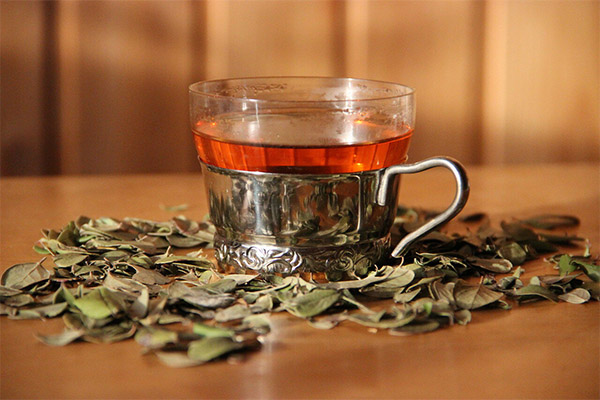
Infusion
There are many different recipes for preparing infusions, but each of them differs in the concentration of medicinal substances in the resulting product. Infusion is the easiest way to prepare a home remedy. Most often three classic recipes are used.
- In a thermos pour 1 tablespoon of leaves, pour 500 ml of steep boiling water. Sustain the infusion for 4 hours, and then take 50 ml at a time.
- The easiest way to prepare - steep 2 tablespoons in 1 liter of boiling water. Insist under a lid for 30 minutes. After that, drink the infusion at 150 ml at one time. You can store it in the refrigerator, no longer than 72 hours.
- Another option - brew 2 tablespoons of raw materials 1 liter of boiling water and cover the container with a lid. The remedy should infuse for 2 hours, then you can use it for internal or external use.
Infusion is prepared for 2-3 days, no more. Although it does not spoil, it loses some of its active ingredients in the finished form when stored for a longer time.
Tincture
Tincture should be prepared only from dried lingonberry leaves, fresh ones will not do. You can add a small amount of dried twigs, so that the remedy turned out more concentrated and fragrant. The recipe consists of the following steps:
- Wash and dry a container with a lid.
- Pour into it at the bottom of 1 tablespoon of crushed cowberry leaves.
- Pour 250 ml of alcohol.
- Close the lid and keep in a dark place for at least 14 days.
The finished tincture must first be strained, and then use dosed according to the rules - 20-30 drops at 1 reception, no more.
Decoction
The decoction of lingonberry leaf contains the maximum benefits for the body, because in the process of preparation it is possible to extract from the plant raw material everything that is in it. It can be cooked over low heat or in a water bath. There can be three different concentrations:
- 2 tablespoons per 1 L of water;
- 1 cup per 1 liter;
- 2 tablespoons per 500 ml.
A stronger decoction is used for external use. If you drink it, you need to reduce the volume for a single application by 2-3 times. Weak, not concentrated decoction is a means for ingestion, sprinkling, inhalation.
Tea
Tea from lingonberry leaves - not just a therapeutic agent, but also a delicious, fragrant drink. It can be served with lingonberry jam, honey or sugar. This is the lightest form of medicine, with a minimal amount of therapeutic elements in the composition. Yet it can be consumed daily without fear of overdose or side effects.
To make the tea, you need to take a handful of dry leaves, brew them in a container with a lid and infuse for 5 minutes. After that, you can pour it into cups and enjoy the fragrant medicine. It is better to prepare tea at once, it does not keep for a long time. The optimal ratio of raw materials and water - 1.5 teaspoons per 500 ml.
Cosmetic applications
Since ancient times, lingonberry has served as one of the main components for the preparation of cosmetics. It is used for various problems with appearance. The plant helps to eliminate the oily shine of hair, make them silky, thick and docile. It can also be used for the beauty of the skin.
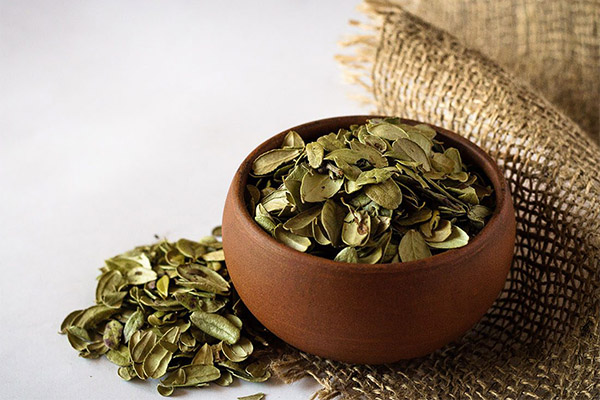
- Hair balm: 20 grams of the collection, 0.5 liters of water and 2 tablespoons of lemon juice. Rinse hair after shampooing and do not rinse.
- If pimples and blackheads often appear on the face, you need to prepare an infusion - 30 g of grass to brew 400 ml of boiling water. Store the liquid in the refrigerator, wipe the skin in the morning and evening before applying moisturizing cream.
- If under the eyes are bags and dark circles, you need to soak cotton pads in the decoction and put on the eyelids for 30 minutes. The effect will be noticeable almost immediately, but for long-term results you need regular application.
- Quickly get rid of freckles, age spots, will help a mixture of fresh lingonberry juice and lingonberry leaves. Rub the mixture into the problem areas and leave it for 5-10 minutes, then wash it off.
- Lingonberry infusion can be used as a remedy for rejuvenation. You need to freeze it in an ice form, use it as a tonic, firming agent. Wipe the face with such ice is only possible if there are no inflammations and boils.
- For long-term use from wrinkles, you can use a strong decoction as a base for tissue masks. If you mix it with rose water, you get an excellent makeup remover.
Using such recipes, you can become more beautiful and look younger, even without expensive procedures in the salon. But you need to watch the reaction of your skin. If there will be redness, flaking, itching, it is better to refuse to use external cosmetics.
Contraindications for use
Lingonberry infusion, decoction or tea from dried leaves is practically harmless, but you need to consume it in moderate amounts, not exceeding the recommended dosage in the treatment. If there is an allergy to cowberries, it is strictly forbidden to use any remedy based on this plant, because it can end in hospitalization. Herbal remedies from lingonberry leaves are contraindicated in such conditions:
- exacerbation of gastritis;
- hyperacidity;
- gastric and intestinal ulcers;
- hypotension;
- acute renal and liver failure;
- kidney stones.
If a person has no such problems, lingonberry leaves can be used as a therapeutic and prophylactic agent. You can use them simply as a tea additive to strengthen the immune system and protect the cardiovascular system. Lingonberry leaves are a treasure trove of medicinal components, which are present in this raw material in great concentration and complement each other's action. Using this plant according to the rules, it is possible to improve the body without pills.
«Important: All information on the site is provided solely for introductory purposes. Before applying any recommendations, please consult with a specialized specialist. Neither the editors nor the authors shall be liable for any possible harm caused by materials."

